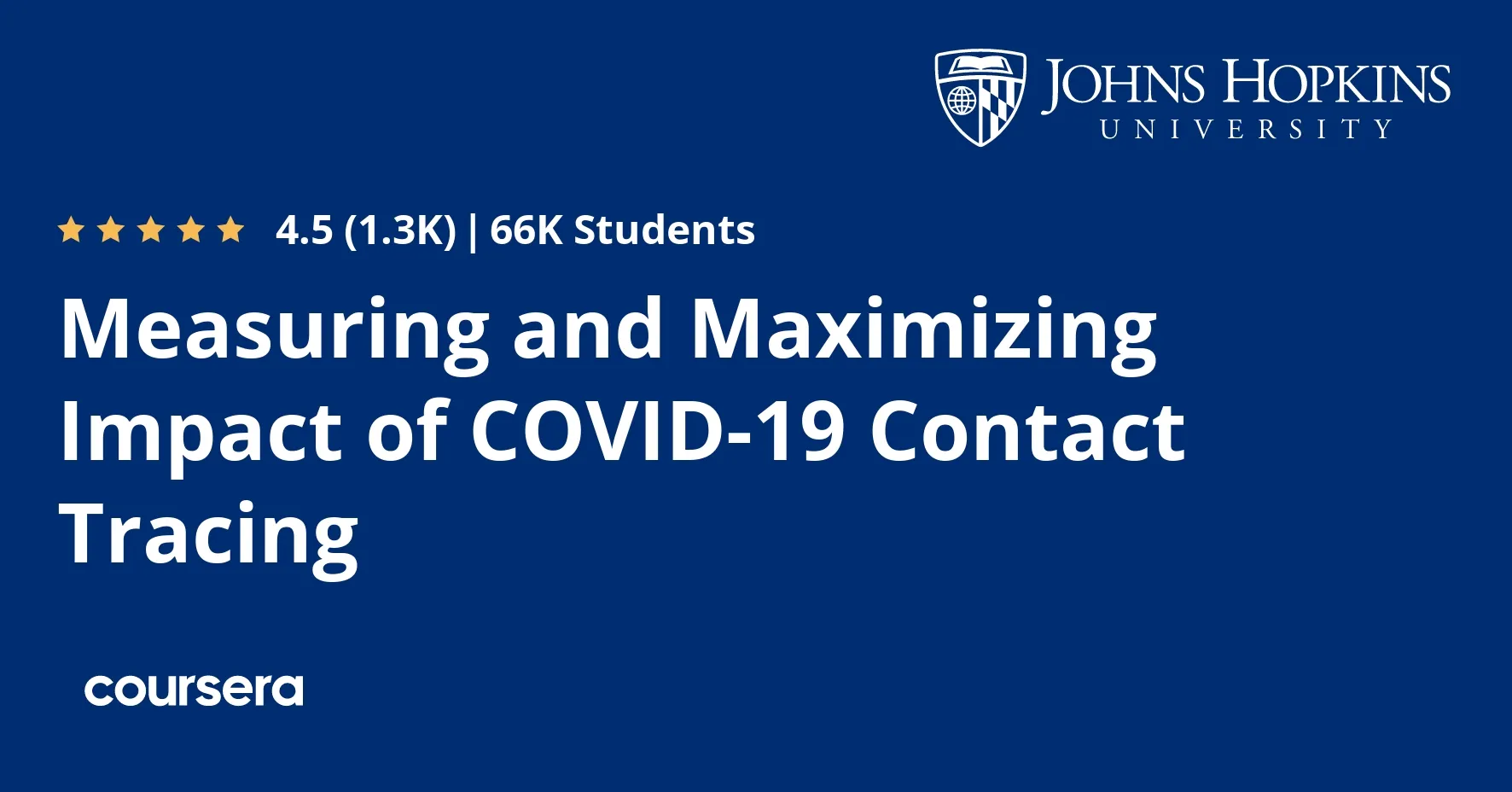
Measuring and Maximizing Impact of COVID-19 Contact Tracing 
This course provides managers and developers of contact tracing programmes with the necessary guidance and tools to measure and maximize the impact of their programmes in the fight against COVID-19. It covers the most important performance indicators and how to project the likely impact of improvements. ▼
ADVERTISEMENT
Course Feature
![]() Cost:
Cost:
Free
![]() Provider:
Provider:
Coursera
![]() Certificate:
Certificate:
No Information
![]() Language:
Language:
English
Course Overview
❗The content presented here is sourced directly from Coursera platform. For comprehensive course details, including enrollment information, simply click on the 'Go to class' link on our website.
Updated in [March 06th, 2023]
This course provides an overview of how to measure and maximize the impact of contact tracing programmes in response to the COVID-19 pandemic. Participants will learn how to determine and calculate metrics and indicators that can be used to assess the effectiveness of contact tracing programmes. They will also use an interactive decision support tool to quantify the potential impact of testing and contact tracing strategies on reducing transmission. Additionally, participants will plan strategies for increasing the effectiveness of contact tracing programmes and learn about the underlying assumptions that the tool uses to estimate the impact of contact tracing programmes.
[Applications]
The application of this course can be used to measure and maximize the impact of COVID-19 contact tracing. Participants can use the metrics and indicators to assess the effectiveness of contact tracing programmes, as well as use the interactive decision support tool to quantify the potential impact of testing and contact tracing strategies on reducing transmission. Additionally, participants can plan strategies for increasing the effectiveness of contact tracing programmes, and learn about the underlying assumptions that the tool uses to estimate the impact of contact tracing programmes.
[Career Paths]
1. Public Health Analyst: Public health analysts are responsible for collecting, analyzing, and interpreting data related to public health issues. They use this data to inform policy decisions and develop strategies to improve public health outcomes. They also work to identify and address emerging public health issues, such as the impact of COVID-19 contact tracing. As contact tracing becomes more widespread, public health analysts will be increasingly in demand to help measure and maximize its impact.
2. Epidemiologist: Epidemiologists are public health professionals who study the patterns, causes, and effects of health and disease conditions in defined populations. They use this information to identify risk factors and develop strategies to prevent and control diseases. With the emergence of COVID-19, epidemiologists are playing an important role in understanding the spread of the virus and developing contact tracing strategies to reduce transmission.
3. Data Scientist: Data scientists are responsible for collecting, analyzing, and interpreting large amounts of data. They use this data to identify trends and develop insights that can be used to inform decision-making. With the emergence of contact tracing, data scientists are increasingly in demand to help measure and maximize its impact. They can use data to identify areas where contact tracing is most effective and develop strategies to improve its effectiveness.
4. Contact Tracing Coordinator: Contact tracing coordinators are responsible for overseeing the implementation of contact tracing programmes. They work with public health officials to develop and implement contact tracing strategies, and they coordinate with local health departments to ensure that contact tracing is conducted in a timely and effective manner. As contact tracing becomes more widespread, contact tracing coordinators will be increasingly in demand to help ensure that contact tracing programmes are effective.
[Education Paths]
1. Bachelor of Science in Public Health: This degree path focuses on the study of public health and its related disciplines, such as epidemiology, biostatistics, health policy, and health services administration. It provides students with the knowledge and skills to understand and address public health issues, including the impact of COVID-19. Developing trends in this field include the use of data science and analytics to better understand and address public health issues.
2. Master of Science in Epidemiology: This degree path focuses on the study of the distribution and determinants of health-related states or events in specified populations, and the application of this study to the control of health problems. It provides students with the knowledge and skills to understand and address public health issues, including the impact of COVID-19. Developing trends in this field include the use of data science and analytics to better understand and address public health issues.
3. Master of Science in Biostatistics: This degree path focuses on the application of statistical methods to the study of biological and medical data. It provides students with the knowledge and skills to understand and address public health issues, including the impact of COVID-19. Developing trends in this field include the use of data science and analytics to better understand and address public health issues.
4. Doctor of Public Health: This degree path focuses on the study of public health and its related disciplines, such as epidemiology, biostatistics, health policy, and health services administration. It provides students with the knowledge and skills to understand and address public health issues, including the impact of COVID-19. Developing trends in this field include the use of data science and analytics to better understand and address public health issues.
Course Syllabus
Review of SARS-CoV-2 transmission
Infectious period and generation time
Reproductive number as indicator of impact of contact tracing
Introduction to performance metrics
Surveillance: Detection and isolation of infected people
Completeness and timing of contact tracing and quarantine
Course Provider

Provider Coursera's Stats at AZClass
This course on Measuring and Maximizing the Impact of COVID-19 Contact Tracing provides learners with the knowledge and skills to identify and calculate indicators and indicators that can be used to evaluate the effectiveness of contact tracing programs. Learners will be able to use interactive decision support tools to quantify the potential impact of testing and contact tracing strategies on reducing transmission. They will also learn how to plan strategies to increase the effectiveness of contact tracing programs and understand the underlying assumptions that the tool uses to estimate the impact of contact tracing programs.
Discussion and Reviews
0.0 (Based on 0 reviews)
Explore Similar Online Courses

Analysis of Everyday Things

CCNA 200-125 Free Video Course: OSPF Mastery

Python for Informatics: Exploring Information

Social Network Analysis

Introduction to Systematic Review and Meta-Analysis

The Analytics Edge

DCO042 - Python For Informatics

Causal Diagrams: Draw Your Assumptions Before Your Conclusions

Whole genome sequencing of bacterial genomes - tools and applications

Healthy and Sustainable Foods

Helping Families Avoid Negative Court Involvement Teach-Out


Start your review of Measuring and Maximizing Impact of COVID-19 Contact Tracing